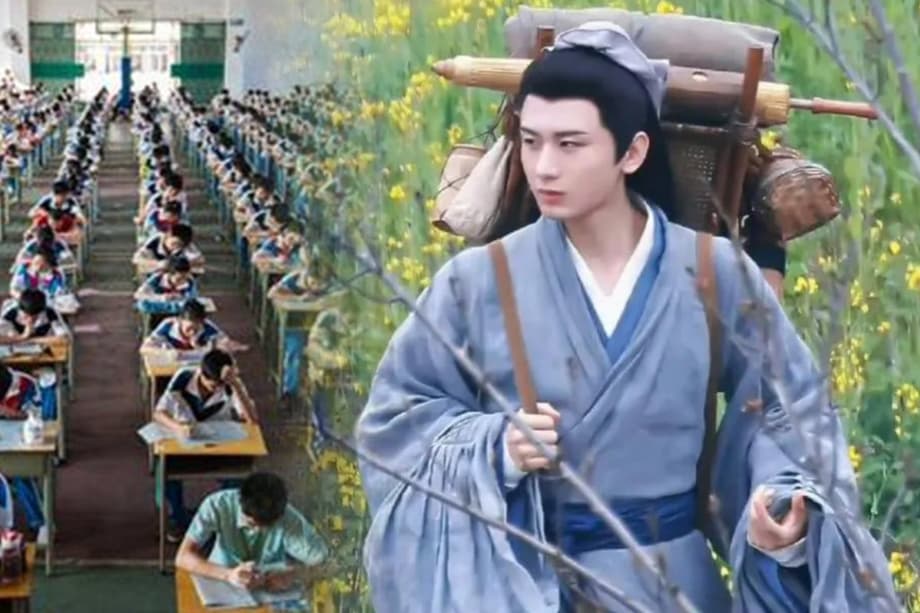Why appearance counted alongside merit
China’s imperial civil service examination, known as the keju, ran for over a millennium and is often highlighted as a historic move toward selection by learning and talent rather than lineage. Even within this merit centered system, examiners sometimes weighed how a candidate looked and carried himself, especially at the very top tier where successful scholars became the public face of the state. In a world steeped in Confucian ethics, a calm bearing, clean presentation, and dignified presence were seen as outward signs of inner cultivation and integrity. Written brilliance opened the door. Presentation and comportment could influence the final ranking.
The system took shape under the Sui dynasty (581 to 618), matured in the Tang (618 to 907), and became deeply entrenched in the Song (960 to 1279), when the main exam cycle fell into a rhythm of once every three years. Despite changes across eras, the curriculum circled around the Confucian classics, history, essay composition, and statecraft. Success required advancing through a long ladder of local and regional screenings before reaching the major hurdles of the provincial, metropolitan, and palace exams.
The palace exam, introduced in the Tang and presided over by the emperor, turned the final ranking into a matter of state. Top finishers earned titles that still resonate in Chinese cultural memory. The first place jinshi was the zhuangyuan, the second was the bangyan, and the third was the tanhua. Tang era custom linked the tanhua to appearance. Before tanhua took on its later meaning as third place, two handsome scholars were chosen to pick flowers and greet the champion, a ceremonial duty that tied beauty and honor together. When tanhua came to denote third place, that association with good looks persisted in cultural retellings of the exam world.
How the imperial exams worked
By late imperial times, the system formed a ladder with many rungs. Local students sought the basic degree, often called shengyuan, through county and prefectural tests. Those who progressed sat the provincial exam to try for the degree of juren. The most gifted traveled to the capital for the metropolitan exam, and the elite among them faced the emperor in the palace exam to compete for the prestigious jinshi degree. Each step had strict proctoring, standardized formats, and severe penalties for cheating.
Success rates were brutal. In many periods only a tiny fraction of candidates progressed. The format demanded mastery of set texts and writing styles, especially the eight part essay during the Ming and Qing. Supporters praised the system for checking aristocratic privilege and creating a scholar official class bonded by a shared learning. Critics lamented the focus on rote learning and argued that exam success often required years of costly preparation that poorer families could rarely afford.
Placement after the palace exam often tracked rank. A top jinshi could expect a fast rise into central ministries or the Hanlin Academy, the finishing school for policy talent. Lower ranked jinshi headed to provincial posts or rotated through more modest assignments. In this setting, the way a candidate presented himself during the palace phase could color imperial impressions.
Appearance criteria across dynasties
Modern readers might ask why beauty or bearing mattered to a system that prided itself on fair selection by learning. Part of the answer lies in the deep historical link in China between outward poise and moral cultivation. Confucian education expected the gentleman, the junzi, to align mind and body. This meant decorum in dress, measured movement, a steady gaze, and speech that was clear and respectful. Officials were expected to lead ritual life, receive foreign envoys, address the court, and model conduct for the common people. Presentation was not a cosmetic extra. It was tied to office.
Physiognomy and virtue
For centuries, Chinese elites debated physiognomy, the idea that a person’s character revealed itself in the face and body. While many scholars warned against overreliance on such judgments, the belief that a cultivated life left traces in a serene expression and upright bearing was common. This does not mean examiners picked the most handsome face in a modern sense. It means they looked for signs of discipline and inner steadiness. A healthy complexion, a composed manner, and a voice that carried without bluster could win favor when the emperor and high ministers met the finalists.
Demeanor as a job requirement
The palace exam differed from earlier written stages. The emperor could question candidates, assess their posture, and sense how they handled pressure in the hall. An impressive essay might secure entry into that hall. A frazzled or careless presence there could dim a candidacy. In some eras, formal rules also screened out candidates with visible criminal tattoos or untreated ailments, which reflected well known practices of marking criminals and the ideal of the whole body as a parental gift that should be preserved.
What did good looks mean in that era
Beauty standards shift across history. In Tang China, plump figures were praised in art and poetry. Later courts favored different aesthetics. These fashion cycles mostly concerned women in literature and painting, yet they hint at a broader point. Appearance was not about a single timeless face. For male scholars, the safe ideal hovered around dignified neatness, composure, and harmony of features. Historical portraits of scholar officials often show a high brow, trimmed hair, simple robes, and a calm set of the eyes. That image matched the expectation that officials should be at ease in ceremony and serious in duty.
The tanhua story sits at the edge of this world of ideals. When the role began as a ceremonial flower bearer, choosing handsome scholars for public facing pageantry made cultural sense. Later, when tanhua defined an exam rank, stories kept alive the link between third place and a pleasing appearance. It became a folk shorthand, a reminder that talent and presentation both mattered in official life.
Meritocracy with limits
Historians often describe the exam system as proto meritocratic. It opened a path into office that did not depend on noble birth, and it weakened old aristocracies. The state tied advancement to a shared curriculum and to performance on standardized tests. Yet the system placed heavy demands on time and money. Families needed tutors, books, and years of leisure for sons to study. Regional quotas sometimes limited mobility. In late times, oversupply of degree holders meant many talented men never gained office. These constraints show that while the system shifted power away from hereditary privilege, perfect equality of opportunity was never achieved.
This mixed legacy helps explain why, at the very top, rulers still cared about the presence of their servants. The emperor wanted loyal, learned, and well mannered aides. The palace exam, where the sovereign ranked candidates, gave him a chance to choose those who could write policy and also stand with grace in ritual.
Modern echoes in public service exams
Contemporary civil service exams in China are not the keju, yet the culture of hard study and fierce competition endures. Each year millions register for the national civil service test, chasing what many call the iron rice bowl of a secure government job. Competition for some positions reaches hundreds of applicants per opening. Agencies look for advanced degrees, targeted majors, and proven writing skill. After written tests, interviews assess logical thinking, clarity of speech, and professional presence. These interviews echo the old belief that an official represents the state and must handle pressure with poise.
Appearance today is governed less by beauty and more by rules and verification. Many exam bodies require recent photographs with application materials. Some ask candidates to maintain the same look across all stages so identity checks are straightforward. Job listings sometimes include health or fitness requirements, especially for customs and border posts that demand shift work or field duty. Across these settings, modern emphasis falls on fairness, transparency, and security, not on grooming ranked as a criterion for merit.
Interviews keep presentation relevant
Public service selection in many countries now blends standardized tests with structured interviews. Panels score how candidates analyze policy, respond to scenarios, and communicate under time limits. This is a practical update rather than a revival of aesthetic judgment. Yet it carries a faint echo of the palace hall. Knowledge matters most, and presence still counts in roles that require public trust.
Debates on fairness
Was it fair for the imperial state to rate a candidate’s looks or manner at the margin after years of study? By modern standards, any scoring of beauty seems exclusionary. Context helps explain, even if it does not excuse. The imperial exam was embedded in a moral philosophy that joined inward virtue to outward conduct. The state also ran a society that excluded large groups from candidacy. Women could not sit the exams. People with disabilities faced barriers. Later critics argued that this culture of testing narrowed the intellectual field and crowded out practical learning. The decision to abolish the system in 1905 came amid sweeping reforms that tried to build a modern school system and military.
The idea of judging merit by learning survived the end of keju. Modern systems moved away from aesthetic preference and toward equal treatment under clear rules. They kept interviews for job fit and public facing competence, but they set boundaries on what can be considered. That shift reflects changes in law and in ideas about rights, as well as a new sense that diversity strengthens state service.
Legacy across East Asia and beyond
The imperial exam shaped far more than individual careers. It created a scholar official class that infused government with a shared literary culture. It spread to Korea, Japan, the Ryukyu Kingdom, and Vietnam in adapted forms. Later, European states studied the model when they built their own career civil services. The Chinese system cannot be credited for every modern testing innovation, yet it did establish the basic idea that a written exam can legitimize state hiring and tie authority to demonstrated learning.
That legacy comes with irony. A system that intended to curb aristocratic power also produced a new elite of degree holders who guarded access to status. Its embrace of decorum and bearing at the summit reflects the ancient belief that leaders must be learned and also look the part. In modern times, the written test and the interview remain, but the idea of ranking beauty has lost legitimacy. Merit now leans toward transparency, relevant skills, and the ability to serve the public with integrity.
Key Points
- The keju ran from the Sui dynasty to 1905 and selected officials by learning rather than lineage
- At the palace exam, emperors sometimes weighed a candidate’s demeanor and presentation
- Tanhua, now known as third place, began as a ceremonial role tied to choosing handsome scholars for flower bearing
- Confucian culture linked outward poise to inner virtue, shaping expectations for officials
- Severe competition and standardized formats defined the exams, with very low success rates in many periods
- Modern civil service exams keep the blend of written tests and interviews, with attention to identity checks and job specific fitness
- Contemporary systems avoid aesthetic judgment and emphasize fairness, clarity of rules, and relevant skills
- The imperial exam influenced selection systems across East Asia and later inspired career civil services in Europe




